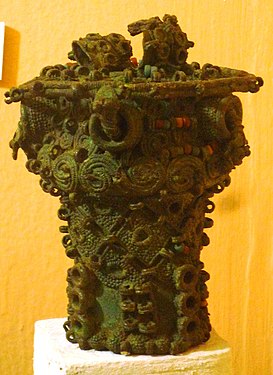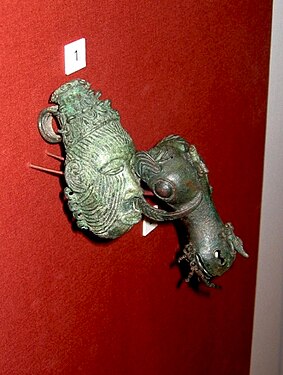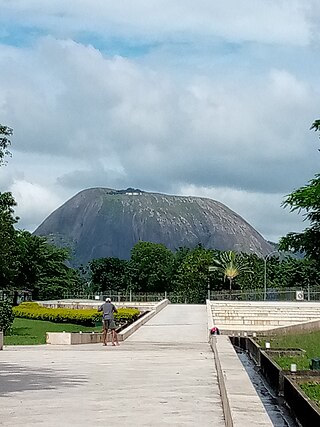
The history of Nigeria can be traced to the earliest inhabitants whose remains date from at least 13,000 BC through early civilizations such as the Nok culture which began around 1500 BC. Numerous ancient African civilizations settled in the region that is known today as Nigeria, such as the Kingdom of Nri, the Benin Empire, and the Oyo Empire. Islam reached Nigeria through the Bornu Empire between and Hausa Kingdom during the 11th century, while Christianity came to Nigeria in the 15th century through Augustinian and Capuchin monks from Portugal to the Kingdom of Warri. The Songhai Empire also occupied part of the region. Through contact with Europeans, early harbour towns such as Calabar, Badagry and Bonny emerged along the coast after 1480, which did business in the transatlantic slave trade, among other things. Conflicts in the hinterland, such as the civil war in the Oyo Empire, meant that new enslaved people were constantly being "supplied".

The Igbo people are an ethnic group in Nigeria. They are primarily found in Abia, Anambra, Ebonyi, Enugu, and Imo States. A sizable Igbo population is also found in Delta and Rivers States. Ethnic Igbo populations are found in Cameroon, Gabon, and Equatorial Guinea, as migrants as well as outside Africa. There has been much speculation about the origins of the Igbo people, which are largely unknown. Geographically, the Igbo homeland is divided into two unequal sections by the Niger River—an eastern and a western section. The Igbo people are one of the largest ethnic groups in Africa.
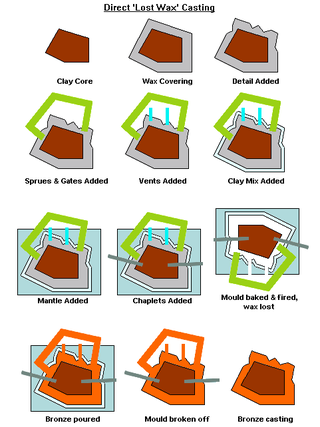
Lost-wax casting – also called investment casting, precision casting, or cire perdue – is the process by which a duplicate sculpture is cast from an original sculpture. Intricate works can be achieved by this method.

Anambra State is a Nigerian state, located in the southeastern region of the country. The state was created on 27 August 1991. Anambra state is bounded by Delta State to the west, Imo State and Rivers State to the south, Enugu State to the east and Kogi State to the north. The State Capital is Awka, while the State’s Largest City is Onitsha which is regarded as one of the largest metropolis area in Africa.

Igboland, also known as Southeastern Nigeria, is the indigenous homeland of the Igbo people. It is a cultural and common linguistic region in southern Nigeria. Geographically, it is divided into two sections by the lower Niger River: an eastern and a western one. Its population is characterised by the diverse Igbo culture and the speakers of equally diverse Igbo languages.
Nri is an Igbo city-state in Anambra State, Nigeria. It was the seat of a powerful and imperial state who was influenced much by the territories inhabited by the Igbo of Awka and Onitsha to the east; the Efik, the Ibibio, to the south; Nsukka and Asaba, and the Anioma to the west. Today, Nri claims to be the heart and origin of the Igbos, but it is historically dated that Igbo Ukwu, formally known as Igbo, and Igbo Nkwo is the true origin and beginning of the Igbos.

Most African sculpture was historically in wood and other organic materials that have not survived from earlier than at most a few centuries ago; older pottery figures are found from a number of areas. Masks are important elements in the art of many peoples, along with human figures, often highly stylized. There is a vast variety of styles, often varying within the same context of origin depending on the use of the object, but wide regional trends are apparent; sculpture is most common among "groups of settled cultivators in the areas drained by the Niger and Congo rivers" in West Africa. Direct images of African deities are relatively infrequent, but masks in particular are or were often made for traditional African religious ceremonies; today many are made for tourists as "airport art". African masks were an influence on European Modernist art, which was inspired by their lack of concern for naturalistic depiction.

The history of Nigeria before 1500 has been divided into its prehistory, Iron Age, and flourishing of its kingdoms and states. Acheulean tool-using archaic humans may have dwelled throughout West Africa since at least between 780,000 BP and 126,000 BP. Middle Stone Age West Africans likely dwelled continuously in West Africa between MIS 4 and MIS 2, and Iwo Eleru people persisted at Iwo Eleru as late as 13,000 BP. West African hunter-gatherers occupied western Central Africa earlier than 32,000 BP, dwelled throughout coastal West Africa by 12,000 BP, and migrated northward between 12,000 BP and 8000 BP as far as Mali, Burkina Faso, and Mauritania. The Dufuna canoe, a dugout canoe found in northern Nigeria has been dated to around 6556-6388 BCE and 6164-6005 BCE, making it the oldest known boat in Africa and the second oldest worldwide.

Oyi is a Local Government Area in Anambra State, Nigeria. It is home to the Oyi people. The towns that make up the local government are Nkwelle-Ezunaka, Awkuzu, Ogbunike, Umuneba, Umunya and Nteje.

The Kingdom of Nri was a medieval polity located in what is now Nigeria. The kingdom existed as a sphere of religious and political influence over a significant part of what is known today as Igboland prior to expansion, and was administered by a priest-king called an Eze Nri. The Eze Nri managed trade and diplomacy on behalf of the Nri people, a subgroup of the Igbo-speaking people, and possessed divine authority in religious matters.

Igbo art is any piece of visual art originating from the Igbo people. The Igbo produce a wide variety of art including traditional figures, masks, artifacts and textiles, plus works in metals such as bronze. Artworks from the Igbo have been found from as early as 9th century with the bronze artifacts found at Igbo Ukwu. With processes of colonialism and the opening of Nigeria to Western influences, the vocabulary of fine art and art history came to interact with established traditions. Therefore, the term can also refer to contemporary works of art produced in response to global demands and interactions.
Igbo culture are the customs, practices and traditions of the Igbo people of southeastern Nigeria. It consists of ancient practices as well as new concepts added into the Igbo culture either by cultural evolution or by outside influence. These customs and traditions include the Igbo people's visual art, music and dance forms, as well as their attire, cuisine and language dialects. Because of their various subgroups, the variety of their culture is heightened further.
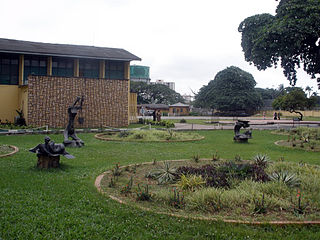
The Nigerian National Museum is a national museum of Nigeria, located in the city of Lagos. The museum has a notable collection of Nigerian art, including pieces of statuary, carvings also archaeological and ethnographic exhibits. Of note is a terracotta human head known as the Jemaa Head, part of the Nok culture. The piece is named after Jema'a, the village where it was discovered. The museum is located at Onikan, Lagos Island, Lagos State. The museum is administered by the National Commission for Museums and Monuments.

Chief Charles Thurstan Shaw CBE FBA FSA was an English archaeologist, the first trained specialist to work in what was then British West Africa. He specialized in the ancient cultures of present-day Ghana and Nigeria. He helped establish academic institutions, including the Ghana National Museum and the archaeology department at the University of Ghana. He began working with the University of Ibadan in 1960, where he later founded and developed its archaeology department. He led this for more than 10 years before his retirement in 1974.
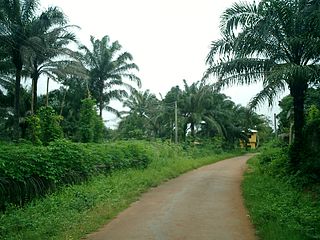
Awka-Etiti, historically known as Awka-Diedo ; later mentioned as Awka-Nkakwu (Okankaku) by colonial authors, is an affluent town comprising seven villages in Idemili South local government area of Anambra state, Nigeria. The seven villages of Awka-Etiti in order of age established are: Nkolofia, Umunocha, Ejighinandu, Iruowelle, Umudunu, Nnaba and Ogunzele.
Opi is a community in Enugu State of southeastern Nigeria. It is populated by the Igbo people and located in Nsukka region. It is the location of a prehistoric archaeological site which contains iron smelting furnaces and slag dated to 750 BC. Iron ore was smelted in natural draft furnaces and molten slag was drained through shallow conduits to collecting pits forming huge slag blocks weighing up to 47 kg. The operating temperatures are estimated to have varied between 1,155 and 1,450 °C.

The archaeology of Igbo-Ukwu is the study of an archaeological site located in a town of the same name: Igbo-Ukwu, an Igbo town in Anambra State in southeastern Nigeria. As a result of these findings, three excavation areas at Igbo-Ukwu were opened in 1959 and 1964 by Charles Thurstan Shaw: Igbo Richard, Igbo Isaiah, and Igbo Jonah. Excavations revealed more than 700 high quality artifacts of copper, bronze and iron, as well as about 165,000 glass, carnelian and stone beads, pottery, textiles and ivory beads, cups, and horns. The bronzes include numerous ritual vessels, pendants, crowns, breastplates, staff ornaments, swords, and fly-whisk handles.

The Ofala Festival is an annual ceremony practiced by Igbo people, particularly the indigenes of Onitsha, Umueri, Umuoji and other neighboring communities such as Aguleri, Nnewi and Ukpo in Dunukofia Local Government Area. It serves as a rites of renewal of the king or Igwe or Obi and it is similar to the Igue festival in Benin and the Ine, Osi or Ogbanigbe Festival in many mid-West Igbo communities of Nigeria. The term ofala, is derived from two Igbo words - ọfọ and ala. The festival is celebrated within two days mostly in October by the Obi and is a customary obligation that must be performed every couple of years without fail.

"Lower Niger Bronze Industry" is essentially a catch-all term referring either to any unattributed "Bronze" work produced in the Lower Niger, or, more commonly, to every "Bronze" work produced in the Lower Niger which cannot be immediately attributed to more famous traditions of Benin and Yoruba metallurgy. These works, referred to in recent texts as LNBs, are quite distinct from previously mentioned ones in both style and production, but are also internally diverse; they do not comprise a single tradition: "while this omnibus term is still with us, no one would continue to lump the Tada-Jebba bronzes together with those excavated at Igbo-Ukwu, even as sub-styles. These and the other provisional groupings reflect distinctly different traditions. Today even the search for a single alternate bronzecasting center has broadened as several independent workshops have been confirmed." As such, one may consider "Lower Bronze Industry" to actually mean Bronze-works which have not yet been assigned to broader traditions, or whose encapsulating traditions/contexts are poorly understood - different scholars additionally do not agree on which pieces should be given the classification. However, though little is known about them, their mere existence suggests that Bronze working was more widely spread in Nigeria than was once known.











